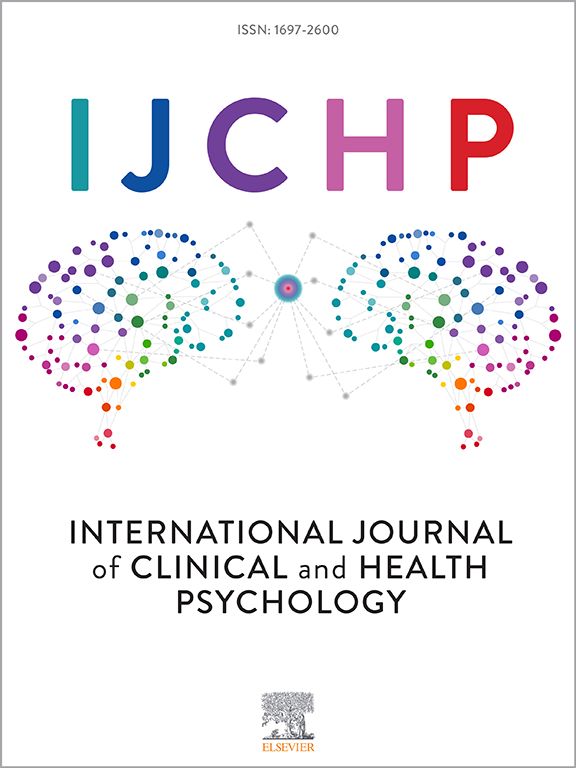Attentional bias toward emotional stimuli in drug-facilitated sexual assault survivors: A two-alternative free-viewing eye-tracking study
IF 4.4
1区 心理学
Q1 PSYCHOLOGY, CLINICAL
International Journal of Clinical and Health Psychology
Pub Date : 2025-07-01
DOI:10.1016/j.ijchp.2025.100625
引用次数: 0
Abstract
Drug-Facilitated Sexual Assault (DFSA) survivors represent an under-researched clinical population that may constitute a distinct psychopathological profile among sexual assault survivors, as their experiences are often accompanied by confusion, memory impairment, and a lack of narrative coherence. This is the first study to investigate emotion-related attentional mechanisms in DFSA survivors using eye-tracking technology, as a window into broader cognitive processing. A clinical sample of 39 women who had experienced a recent, isolated sexual assault (19 DFSA, 20 non-DFSA) and 35 demographically matched non-exposed controls completed a free-viewing task while their eye movements were recorded. Participants viewed emotional images (threatening, happy, and neutral) paired with control neutral scenes. DFSA survivors showed a clear attentional bias toward threatening images during later attentional stages (engagement and sustained attention), while non-DFSA survivors did not exhibit significant modulation based on emotional content. Controls displayed typical emotion-driven attention, with sustained focus on happy stimuli. PTSD symptom clusters also influenced attentional patterns: greater avoidance was associated with reduced fixation time to emotional scenes, and dissociative symptoms with increased fixation time to neutral ones. These symptoms were more prevalent in the non-DFSA group. These findings suggest that attentional responses to emotional information vary according to assault typology and are shaped by specific PTSD symptom profiles. Clinically, this highlights the need for trauma interventions tailored to individual patterns of attention and emotional engagement. In particular, DFSA survivors may benefit from strategies that address threat sensitivity, while non-DFSA survivors may require approaches that promote emotional reconnection and reduce avoidance.
药物性侵犯幸存者对情绪刺激的注意偏向:一项两种选择的自由观看眼动追踪研究
药物辅助性侵犯(DFSA)幸存者代表了一个研究不足的临床人群,他们可能构成了性侵犯幸存者中独特的精神病理特征,因为他们的经历往往伴随着混乱、记忆障碍和缺乏叙事连贯性。这是第一个使用眼动追踪技术调查DFSA幸存者情绪相关注意机制的研究,作为更广泛认知处理的窗口。临床样本是39名最近经历过孤立性侵犯的女性(19名DFSA, 20名非DFSA)和35名人口统计学匹配的非暴露对照组,她们完成了一项自由观看任务,同时记录了她们的眼球运动。参与者观看了带有情绪的图片(威胁的、快乐的和中性的)和对照中性的场景。DFSA幸存者在后期的注意阶段(参与和持续注意)对威胁性图像表现出明显的注意偏倚,而非DFSA幸存者没有表现出基于情绪内容的显著调节。控制组表现出典型的情绪驱动型注意力,持续关注快乐的刺激。PTSD症状群也影响注意模式:更大程度的回避与对情绪场景的注视时间减少有关,而分离症状与对中性场景的注视时间增加有关。这些症状在非dfsa组中更为普遍。这些发现表明,对情绪信息的注意反应根据攻击类型而变化,并受到特定的创伤后应激障碍症状特征的影响。在临床上,这突出了针对个体注意力和情感投入模式进行创伤干预的必要性。特别是,DFSA幸存者可能受益于解决威胁敏感性的策略,而非DFSA幸存者可能需要促进情感重建和减少回避的方法。
本文章由计算机程序翻译,如有差异,请以英文原文为准。
求助全文
约1分钟内获得全文
求助全文
来源期刊

International Journal of Clinical and Health Psychology
PSYCHOLOGY, CLINICAL-
CiteScore
10.70
自引率
5.70%
发文量
38
审稿时长
33 days
期刊介绍:
The International Journal of Clinical and Health Psychology is dedicated to publishing manuscripts with a strong emphasis on both basic and applied research, encompassing experimental, clinical, and theoretical contributions that advance the fields of Clinical and Health Psychology. With a focus on four core domains—clinical psychology and psychotherapy, psychopathology, health psychology, and clinical neurosciences—the IJCHP seeks to provide a comprehensive platform for scholarly discourse and innovation. The journal accepts Original Articles (empirical studies) and Review Articles. Manuscripts submitted to IJCHP should be original and not previously published or under consideration elsewhere. All signing authors must unanimously agree on the submitted version of the manuscript. By submitting their work, authors agree to transfer their copyrights to the Journal for the duration of the editorial process.
 求助内容:
求助内容: 应助结果提醒方式:
应助结果提醒方式:


